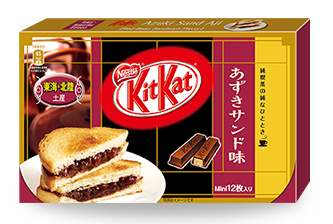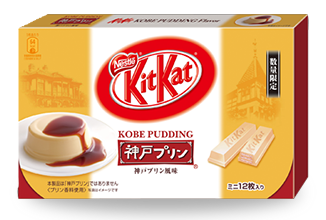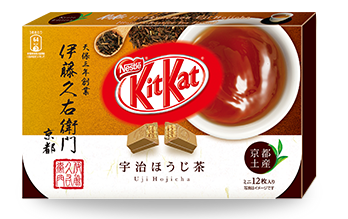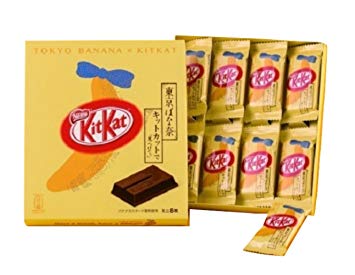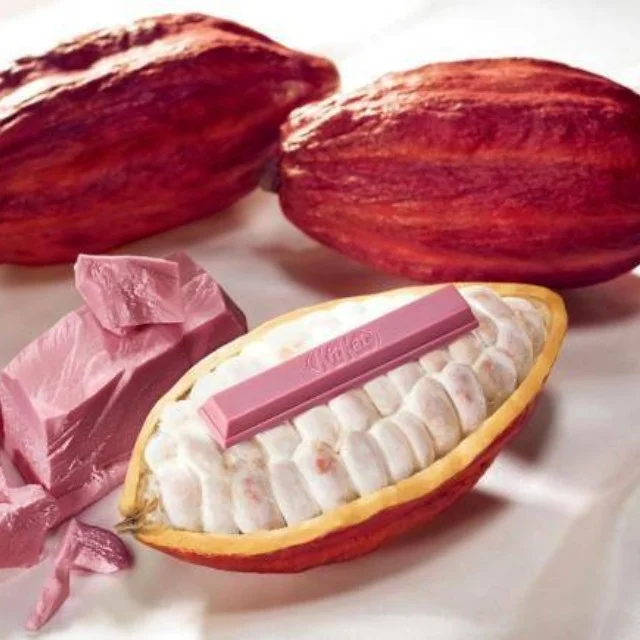Hello Kitty Kat: How the Kit Kat conquered Japan
How a classic British chocolate bar marketed at working men became a modern must-have Japanese treat.
For my grandpa, who really loved Kit Kats (though probably not the matcha or edamame varieties).
Kit Kats are sold in more than 100 countries across the globe, with 700 wafer fingers consumed every single second. That’s about 22 billion Kit Kat fingers a year.
It’s also one of Japan’s best selling chocolate brands, having produced over 400 different flavours in since it was introduced 46 years ago. To Western palates, the flavours range from the ordinary (milk, white and dark chocolate), to the more unusual (pancake, cherry blossom, creme brulee), and the downright bizarre (cough drops, college tater, seafood).
But how did an early twentieth century chocolate bar marketed at working British men become a must-have Japanese treat?
A brief timeline of Kit Kat
Before diving into Japan’s love affair with the chocolate wafer, here’s a quick run down of Kit Kat’s history.
1911
Rowntree’s, the famous confectionery company based in York, England, trademarks the names Kit Cat and Kit Kat (but doesn’t use the name on any of its chocolate treats).
1920s
The company uses the name on a product for the first time, calling one of their assortment boxes Kit-Cat Chocolates.
1935
The first four-fingered wafer is made by Rowntree’s, though it’s called Rowntree’s Chocolate Crisp, not Kit Kat. The Chocolate Crisp is marketed as an affordable product for the working man. The use of wafer helps keep the price below that of a solid chocolate bar.
1937
The name Kit Kat appears alongside Rowntree’s Chocolate Crisp, as a nickname for the chocolate bar. It quickly becomes the company’s most popular product, and is endorsed by Churchill’s government who promote it as a healthy and cheap wartime food.
1941
Due to food shortages caused by WWII, Rowntree’s changes the beloved Chocolate Crisp recipe, using dark rather than milk chocolate. Rather than upset fans, the confectioner launches a new bar in a blue wrapper called KIT-KAT, accompanied by adverts which read ‘No More Chocolate Crisp Till After The War’.
Post-1945
The Chocolate Crisp returns to its milk chocolate form and reverts to its original red wrapper .
1949
The name Chocolate Crisp is finally dropped and Kit Kat becomes the official name.
1950s
Kit Kat expands into Australia, New Zealand, South Africa and Canada. This is also the decade the slogan ‘Have a Break, Have a Kit Kat’ is born.
1970s
The chocolate bar reaches markets in Europe and the US.
1973
Kit Kat reaches Japan - where it’s called KITKAT - through a partnership with the Japanese Confectionary company, Fujiya.
1988
Rowntree’s is acquired by Swiss food and drink company Nestlé
2000s
The Kit Kat becomes a mega-hit in Japan. But why?
Local luxuries: Tapping into omiyage
Kit Kat was introduced to Japan in 1973, but the story of its success really began about three decades later. In the early 2000s, a strawberry-flavoured version of the bar was introduced exclusively to the island of Hokkaido, tapping into the Japanese culture of omiyage.
In English, omiyage translates to ‘souvenir’, but it can be more accurately described as the practice of bringing back local food items from one’s travels to give to family, friends and coworkers.
The strawberry Kit Kat so successfully tapped into omiyage that it led to more limited edition and localised varieties. To date, more than 400 weird and wonderful flavours have been created. There are currently 15 local flavours on sale, including purple sweet potato from Okinawa, roasted tea from Kyoto, adzuki bean-sandwich from Hokuriku and wasabi from Sizuoka and Kanto.
What’s in a name? Kitto katsu and the student market
But the success of Kit Kat isn’t down to omiyage alone.
Another reason was a serendipitous similarity between the chocolate bar’s name and the Japanese phrase ‘kitto katsu’, a common good luck blessing which roughly translates to ‘you will surely win’. During the early 2000s, Nestlé noticed a surge in sales every January as customers bought the wafers as good luck gifts for students sitting their exams.
Speaking to The Telegraph in 2005, a spokesperson for Nestlé Japan said, ‘We're finding that parents are buying them for their children for exam days, but also some determined pupils are buying Kit Kats for themselves as a sort of reminder that they are really going to give these exams their best shot.’
Nestlé quickly capitalised on this trend. In 2009 they collaborated with Japan Post to sell a special Kit Kat package which could be sent to university students as a good luck gift. In recent years the chocolate bar has become so associated with the exam period that in 2015 around 300,000 students received one - about half of all exam-sitting students.
Kit Kat and Japan Post.
An appetite for innovation
It’s also Japan’s unconventional relationship with chocolate that allows the more unusual Kit Kat flavours to flourish. ‘Chocolate is a very recent concept in Japan,’ explains Alex Viella, of Nestlé Japan. ‘Dutch sailors first brought it into Japan hundreds of years ago, but it really only caught on after World War Two, during the American occupation. The way of consuming chocolate in Japan is quite different from the UK’.
Because chocolate culture is relatively new, the Japanese don’t mind messing with it in ways we’d find sacrilegious in the West. But while they’ve had hundreds more varieties of Kit Kat than we’ve had in Europe and the US, the country’s annual consumption of chocolate is low by comparison. In 2015, the average Swiss person ate around 8.8kg of chocolate, Germans about 8.4kg and Brits around 6.8kg, while the average Japanese person ate just over 2kg.
Per capita consumption of chocolate in kilograms, 2015
‘Compared to other countries, Japan has an overwhelming variety of sweets to choose from, including traditional wagashi (Japanese-style confectionery),’ says Yasuko Fujita, deputy secretary-general of the Chocolate and Cocoa Association of Japan. ‘People here have so many different types of sweets to choose from that they don’t necessarily eat chocolate everyday.’
Raising the bar
This idea of chocolate as an occasional treat is one of the reasons that Kit Kat Chocolatories - upmarket stores that create and sell luxurious versions of the chocolate bar - are so popular in Japan.
There are now eight Chocolatories in the country, all under the stewardship of classically trained pâtissier Yasumasa Takagi. ‘Only the fanciest bars are devised by Takagi,’ writes Tejal Rao, in the New York Times, and they’re made with higher-grade chocolate and more premium ingredients. According to CNN Travel, you can ‘build the KitKat of your dreams’, by choosing your own base and toppings. But be cautious, a normal bar will set you back about £4.50-£7 (US$6-9), with the most luxurious toppings costing up to £14 (US$18).
Current premium iterations include the Sublime Bitter, made with 66% cacao, the Special Butter, a combination of butter and chocolate, and the Sublime Volcanic Philippines, which uses cocoa from the island of Mindanao, ‘said to be the home of gods and fairies’, according to Kit Kit Japan.
Kit Kat Chocolatory.
Kit Kat’s big break
And so, in answer to my earlier question, how did an early twentieth century chocolate bar marketed at working British men become a must-have Japanese treat? 1) Some clever marketing people capitalised on the culture of omiyage. 2) They also capitalised on a lucky linguistic similarity between Kit Kat and the phrase kitto katsu, successfully cornering the student marketing. 3) Kit Kat Japan embraced the weird and the wonderful, experimenting with flavours and churning out various new varieties each year. 4) They turned the Kit Kat into a chocolate chameleon, both ordinary and luxurious.
Thanks for reading. Have a break, have a gold leaf covered Kit Kat.
More Kit Kat facts
The Kit Cat Club
The origin of the name ‘Kit Kat’ came from late 17th century London, when a literary group met at pie shop run by the pastry chef Christopher Catling. The band of writers became known as ‘the Kit Cat club’, after an abbreviation of the owner’s name. Archivists from Nestle UK discovered that Rowntree’s workers had frequented the club, which later led to the trademark.
Christopher Catling.
The first flavour
Orange was the first new flavour of Kit Kat when it was introduced into UK markets in 1996. Its success led to other new varieties, including mint, dark, and caramel, while the Kit Kat Chunky in 1999. (Which is known as Big Kat and Kit Kat Extra Crispy in the US.)
Kit Kat sushi
After an April Fool’s Day ad for sushi Kit Kats went viral in Japan, three limited edition Kit Kat ‘sushi’ sets were released in 2017. The sushi set consisted of tuna (which actually tasted like raspberry), seaweed (which tasted of pumpkin pudding) and sea urchin (which, thankfully, was melon with mascarpone).
Kit Kat ‘sushi’
The fourth and the first
In 2018, Nestlé Japan released the Sublime Ruby, the world’s first ever chocolate bar made from ruby cacao beans, a new type of chocolate which is distinct from dark, milk and white. In fact, according to Forbes, the first limited run of 5,000 bars sold out immediately, with black market springing up around the products as people sold them for a marked up price.
Kit Kat Ruby Sublime.
Kit Kash
In 2018, the Kit Kat chocolate was the sixth most valuable in the world, behind Cadbury, Kinder, M&M’s, Hershey’s and Snickers.




